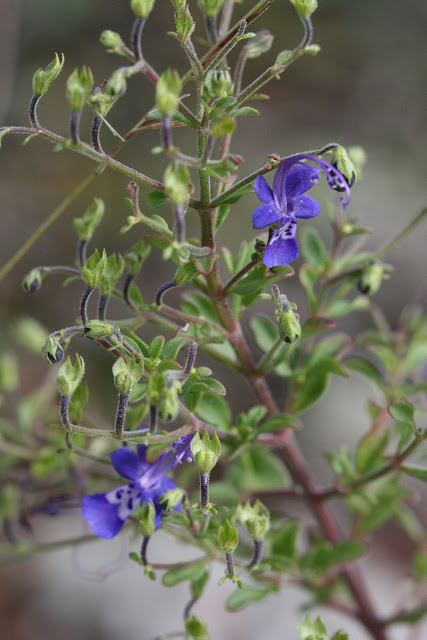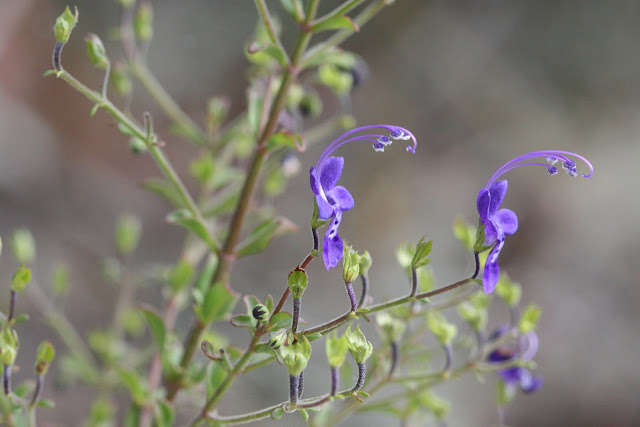Blue curls (Trichostema dichotomum) is a member of the mint family and common throughout Florida and the eastern half of North America, including the southern provinces of Canada. In Florida, it naturally occurs in a wide variety of well-drained habitats and colonizes disturbed sites fairly quickly as well.
Blue curls is an annual, dying shortly after it disperses its seeds in late fall. Like many mints, however, it produces huge numbers of seeds and there is never any danger of losing it once planted - if you do not mulch heavily and the seeds can find the soil surface. In fact, this is one of the few drawbacks to adding this plant to the home garden; it often spreads and has to be held in check by thinning it each year as the seedlings arise.
As a foliage plant, blue curls is not especially distinctive. It has a thin woody stem and soon becomes multi-branched. At maturity, it may reach 2 feet tall. The leaves are thin and ellitical, and like most mints, are quite fragrant when bruised. The fragrance is not especially "minty" and few would plant or use it in a potpouri for its scent.
Its the long season of flowering that makes blue curls worth a place in the home landscape. Flowering generally begins in the early summer and may continue well into early fall. Individual flowers are small, but an intense blue and exceptional in character. The lower petals are distinctively spotted while the reproductive parts - the stamens and styles - are long and curled. The flowers remain open only in the morning hours so this is not a plant for late risers to appreciate. My wife, Alexa, and I love to walk about our landscape with a cup of coffee early in the morning to appreciate this plant in full bloom. Individual flowers open for only a morning, but more take its place each day. Blue curls are pollinated mostly by bees. They are not a good butterfly flower.
Blue curls is often available from native plant nurseries. Because it spreads quickly in nearly any landscape setting except very wet and/or shady sites, you do not need to start with too many plants. Use it in the middle portion of a mixed wildflower planting where it will be noticeable in bloom, but disappear among other plants when it is not. Just be prepared to thin each year's seedlings to keep it from becoming too numerous.





I think I may have seen this plant in my yard. I saw it once, without my specs, when I was thinking of other things. It's stopped blooming now, of course. I hope it was this!
ReplyDeleteGreat blog Thanks for the id
ReplyDeleteThis plant was recently offered at my local native plant center, so I was wanting to learn about it. This description is multi-faceted and seems to cover all important aspects of growing it. Thanks
ReplyDeleteThanks for the cultivation remarks. At my homestead the woods in Wetumpka, FL, the landscaping goal is to try to limit introduced wildflowers to seed from wild plants growing within this drainage, Bear Creek. A bit up slope from me are sites with thousands of Blue Curls showing off right now, mid October and I'd like some to come closer.
ReplyDeleteThanks for the info. The Blue Curl showed up in our flower bed beside a concrete driveway. We started to pull it out but my wife let it stay and we am so glad we did. It has the most delicate beautiful flower I have ever seen on a wild flower. After reading your info we will clear a portion of our bed in hopes the seed will produce next year. So excited about this plant. We live in Brunswick co. NC and according to what we read it is rare in this area. Have lots of close up
ReplyDeletepictures to show off our find
I am growing this Blue Curls plant in the shadehouse at Eagle Landscape Nursery in Narcoossee, because it becomes very stressed in containers out in full sun. I find it to be very attractive, with its rounded shape and tiny blue flowers.
ReplyDeleteI have enjoyed flowering blue curl for several years but this year it has not bloomed. The plants have spread and look healthy. But no blooms. Are they missing some important food or other soil nutrient?
ReplyDeleteNot sure what your problem would be. Normally, problems like these are caused by sunlight - too little or not enough. Less commonly, major issues with soil moisture. Blue curls is not very sensitive to site conditions in my experience.
Delete